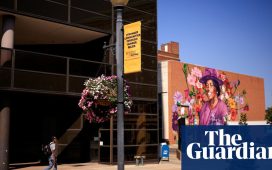YUMA, Ariz. — Central American parents and children started pouring into this desert border community faster than anyone had predicted. Out of desperation, the Salvation Army opened a shelter in a strip mall in March, thinking it would be temporary. At first, they had 50 people. Then 150. Then the numbers doubled by the week.
Churches issued urgent calls for diapers, baby formula, coloring books and crayons. Aid workers flew in from Washington. The mayor, who opposes illegal immigration, declared an emergency and implored the White House to help because the flow of people coming out of federal detention at the border was unlike anything Yuma had ever seen.
“I’m not interested in seeing homeless and hungry families walking around the city looking for resources and all the issues that come with that,” Republican Mayor Douglas Nicholls said in a recent interview at City Hall. “It’s a big issue.”
In the Border Patrol’s Yuma sector, which stretches from California deep into the Arizona desert, half of the apprehensions this year have been of children — the highest share on the U.S. southern border. The tally is rising fast in Yuma, a sparsely populated farming community in Arizona’s southwest corner, driven in part by migration patterns that shift frequently as people try to determine the path of least resistance to the United States.
Asylum-seeking migrants arriving dusty and exhausted here in recent days said it is easier than ever to enter the United States if they surrender with a child. Because minors generally cannot be held for long periods, most are released with their families or to a shelter.
Nearly 169,000 youths have surrendered at the southern border in the first seven months of this fiscal year, and more than half are ages 12 and under, according to federal records and officials familiar with Customs and Border Protection statistics. Minors now account for nearly 37 percent of crossings — far above previous eras, when most underage migrants were teenagers and accounted for 10 percent to 20 percent of crossings.
“I don’t think we’ve ever seen anything near this,” said John Sandweg, an acting director for Immigration and Customs Enforcement under the Obama administration.
The children have shattered a multibillion-dollar system that Congress and the White House built over the past two decades to quickly catch and deport adults, and border scenes involving children have been surreal: One boy recently surrendered in a Teenage Mutant Ninja Turtles costume, a girl carried a pink-clad doll and border agents are feeding formula to newly apprehended babies.
Migrants say they are coming to the United States because droughts are frying Central American harvests, they can’t pay their bills and gangs are recruiting children.
“I want to study,” said Cesar Gonzalez, 13, of Guatemala, wearing a donated sweatshirt with “USA” emblazoned across his chest, soon after he was released from custody, as he and his family waited at the Yuma airport for a flight to Boston. “And then I can work to help my father.”
Families are increasingly heading to the desert dunes of Arizona’s southwest corner because they sense the U.S. government’s focus is on the Texas border along the Rio Grande and because Arizona has less space for detention beds, meaning they are more likely to be released quickly.
“On other borders, they’re deporting people,” said a mother of three named Queny, who asked not to disclose her last name. She said her Central American family of five, including a nursing 1-year-old, paid less than $6,000 to cross, cheaper than the price for smuggling an adult. In Arizona, they were released within days.
Yuma traces its roots to the 19th century gold rush; it is now known as the nation’s “winter lettuce capital” and is home to the military’s Barry Goldwater bombing range. Most newcomers are either migrant farmworkers from Mexico or snowbirds heading south for the winter.
In October, the Border Patrol released about 200 Central American family members, and nonprofit groups, lacking shelter space, housed them in local motels. Federal agents have apprehended more than 31,000 family members here since, nearly four times the amount from the same period last year, and warned Yuma to expect hundreds more in a city that has a small airport, a few bus stops and an occasional train.
The Salvation Army stunned neighboring business owners in a Yuma strip mall when it opened a shelter in March, installing portable toilets and showers behind the building.
“I thought it was a joke,” said Alma Mosier, a registered nurse who owns Cheekie Boutique, a women’s clothing store. She expressed concern about federal officials’ assertions that some children are making repeat trips to help adults enter the United States. “Where are the little kids coming from? Are they recycling the kids over and over? You want to protect the kids, you know?”
Latinos make up more than 60 percent of Yuma County’s population, and more than a quarter of the county’s population are immigrants. Though Latinos generally lean left, Yuma is politically divided. Some embrace President Donald Trump’s hard-line approach to immigration policy; a few have driven by the shelter and shouted at the families to go home.
Others help. They serve meals, sort donated clothes and monitor the shelter around the clock. Some drive families to the airport, or escort them to the new bus stop out back. Piles of shampoo, diapers and canned goods are arriving, but it’s difficult to keep up with demand.
“It’s basically a revolving door,” said Salvation Army Captain Jeffrey Breazeale. “I’ve been told it’s not going to slow down.”
Sister Mary Beth Kornely, a member of the Franciscan Sisters of Christian Charity in Yuma, said the local Immaculate Conception Catholic Church asks for volunteers or supplies at Sunday services.
“The need is extremely great because the numbers just keep pouring in,” Kornely said.
Though Trump’s proposed $4.5 billion in border spending includes humanitarian aid and enforcement, Democrats worry that the approach doesn’t adequately address the children, whom one lawmaker called the “cannon fodder in Trump’s reelection campaign.”
“I’ve never seen it this bad, and I think it’s going to get worse,” said U.S. Rep. Raul Grijalva, D-Ariz., who recently visited Yuma. “As kids, they are now part and parcel of a presidential election. As that campaign escalates as they become more desperate, so will the situation on the border.”
So far, locals have shouldered the cost. The mayor, a Republican married to the daughter of a Mexican immigrant, has dispatched city workers to help. The Democrat-led County Board of Supervisors voted unanimously to spend up to $25,000 to cover shelter utilities, if it expands.
“I oppose illegal immigration because it’s illegal, but what you see now is migration. It’s lawful,” said Russell McCloud, board vice chairman and a Republican, referring to Central American asylum claimants. “That’s the issue, right? Otherwise they would be stopped and turned away.”
At Border Patrol facilities, advocates say, children fall eerily silent. But at the shelters, they come alive. They play, throw tantrums, cuddle with stuffed animals. They have their own thoughts about what is good about America. Some wish for a bicycle, others for a better education. Some said they want to send money to the parents and siblings left behind.
Inside a converted monastery in Tucson run by Catholic Community Services of Southern Arizona, adults sipped coffee and children rode bicycles past orange trees in the yard one recent day. Medics roamed the halls. Offices were set aside for consulates, lawyers, phone calls, and clothing donations. Children carried stuffed animals: a teddy bear, a dinosaur, a lamb.
And they pointed to their destinations on giant maps of the United States: Tennessee, Arkansas, Florida.
Emmanuel and Ayembi, twin brothers from Guatemala, are going to Pennsylvania to meet their grandfather for the first time. Their mother, Beisy, 22, hasn’t seen him since he left Guatemala 15 years ago to work and send money home.
A Honduran woman named Lilian burst into tears when asked how smugglers treated her along the journey. She said she left Honduras because her mother has cancer and needs more money to pay for treatment.
“I couldn’t afford it,” she said, wiping away tears so her daughter, Adriana, 3, wouldn’t see.
Nearby, 4-year-old Sofia roamed the second-floor hallway in blue pajamas, keeping an eye out for Mickey Mouse. To quiet Sofia and her siblings — Rigoberto, 1, and Claudia, 8 — their mother had told them they were going to Disneyland.
“Where is he, Mami?” the girl kept asking, hoping to see the famous Disney character, her mother said. “When are you going to take me to him?”
“She thinks we’re going on vacation,” Queny said with a whisper, saying she fled a cheating husband and plans to stay with a friend in North Carolina. “We are going to work.”
South of Yuma, on the other side of the Mexican border, more families are waiting to get in.
One recent night, children played with Barbie dolls and coloring books on a filthy sidewalk beside a traffic-clogged street. They slept under blue tarps weighed down with rocks and pressed against a towering border fence fortified with razor wire. They pay a few pesos to a lady down the street to bathe or wash their hair. They are trying to cross legally, and they have been waiting for three months.
A boy played on a towering fence that separates Mexico and the United States. Another swung police tape like a cowboy lariat. A stray dog followed them wherever they went. They named him Firulay.
The people who suffer are the children,” said Rosa, who traveled to the border with her 10-year-old daughter, Ruth, an aspiring airline stewardess from El Salvador. “They could be smiling and playing, but only they know how they feel.”
Evelyn, a gaptoothed little girl from Mexico traveling with her mother, Marisol, held up a doll and smiled. She turns 6 in November.
“My birthday will be on the other side,” she said.









